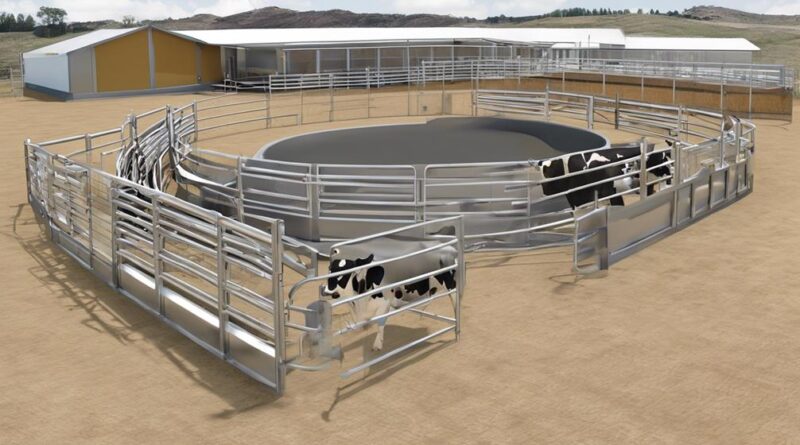What Are the Key Features of Modern Cattle Handling Facilities?
You might be thinking that modernizing cattle handling facilities is a costly and complicated process. However, with the right features in place, the long-term benefits far outweigh the initial investment.
From efficient layout and design to advanced handling equipment and technology integration, the key features of modern cattle handling facilities are designed to streamline operations, ensure the safety and well-being of the animals, and improve overall productivity.
But what exactly are these features and how do they contribute to the success of a modern facility?
Efficient Layout and Design
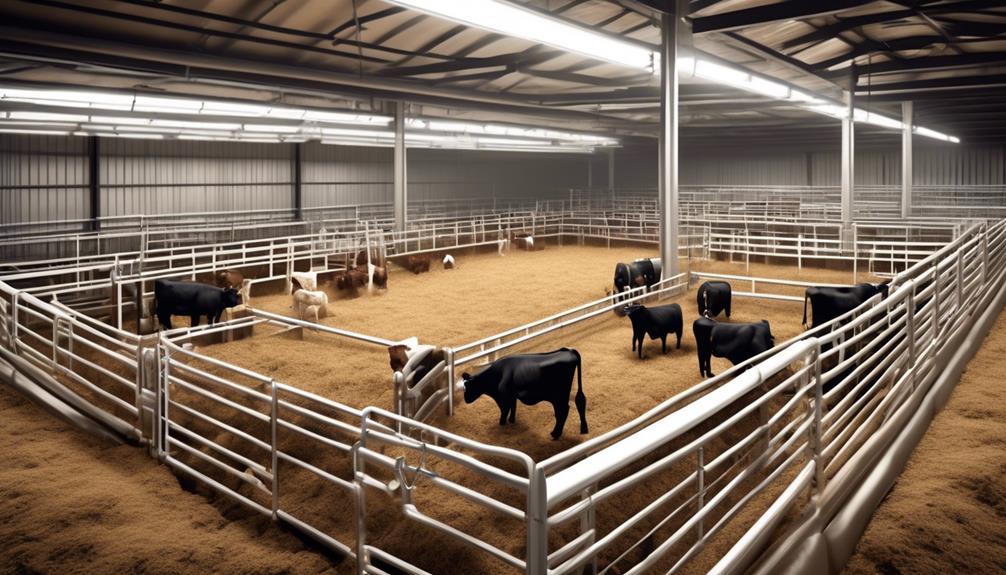
For efficient cattle handling facilities, it's essential to carefully plan the layout and design to optimize workflow and minimize stress on the animals. One key aspect of efficient workflow is the strategic placement of pens, alleys, and gates. By organizing these elements thoughtfully, you can create a smooth and logical flow for moving cattle from one area to another. This not only reduces the time and effort required to handle the animals but also minimizes their stress levels.
Additionally, space optimization is crucial for maximizing efficiency. Designing the layout to minimize unnecessary movement and maximize use of available space can significantly improve the overall workflow.
When designing the layout, consider the most common tasks and movements involved in handling cattle. Place sorting pens and holding areas near the working facilities to minimize the distance cattle have to travel. This reduces the time and effort required to move them, contributing to a more efficient workflow. Furthermore, optimizing space involves carefully planning the size and layout of the facility to ensure that it can accommodate the anticipated number of animals without creating congestion or inefficiencies.
Incorporating curved chutes and non-slip flooring can also contribute to efficient workflow and space optimization. Curved chutes reduce the likelihood of cattle balking or stopping, keeping the flow moving smoothly. Non-slip flooring helps maintain a calm and steady pace, preventing injuries and reducing stress. These design elements not only contribute to the efficiency of handling procedures but also prioritize the well-being of the animals.
Safe and Low-Stress Handling
To ensure safe and low-stress handling of cattle, prioritize clear communication and gentle movements when interacting with the animals. Understanding low-stress techniques and animal behavior is crucial for maintaining a calm environment and ensuring the safety of both the cattle and the handlers. Here are key strategies to implement safe and low-stress handling:
- Understanding Animal Behavior: Familiarize yourself with the natural behavior of cattle. Recognize their flight zones and points of balance to effectively move and direct them without causing undue stress. By understanding how cattle perceive and respond to stimuli, you can minimize their anxiety levels during handling.
- Gentle Handling Techniques: Implement gentle handling methods that avoid sudden movements or loud noises. Approach cattle quietly and calmly, using slow and deliberate actions to guide them. Avoid aggressive behavior, such as yelling or excessive prodding, as it can agitate the animals and lead to unsafe conditions for both the cattle and the handlers.
- Proper Communication: Clear communication among handlers is essential for safe and low-stress cattle handling. Establishing consistent signals and cues ensures that everyone is on the same page when working with the animals. Effective communication helps prevent misunderstandings and reduces the likelihood of agitating the cattle due to conflicting directions.
Advanced Handling Equipment
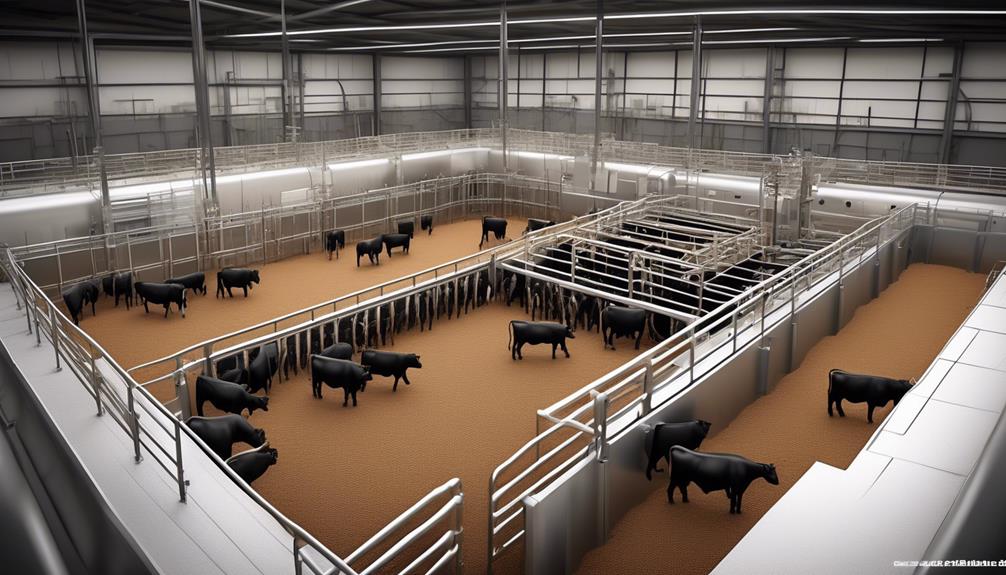
When considering modern cattle handling facilities, utilizing advanced handling equipment can significantly enhance efficiency and safety. Advanced handling equipment is designed with a focus on animal welfare, ensuring that the handling process minimizes stress and discomfort for the cattle. This includes features such as adjustable restraint systems that conform to the animal's size, reducing the risk of injury and agitation during handling procedures. Additionally, advanced equipment often incorporates noise-reducing technology, minimizing the disturbance to the cattle and promoting a calmer environment.
Furthermore, advanced handling equipment not only benefits the cattle but also simplifies the tasks for the handlers. The use of hydraulic systems and automated controls streamlines the handling process, allowing for smoother and more precise movements. This not only improves efficiency but also reduces the physical strain on handlers, contributing to a safer working environment.
In terms of equipment maintenance, modern handling facilities often integrate advanced technologies that facilitate easier upkeep. For instance, some equipment is designed with durable materials and coatings that are resistant to corrosion and wear, reducing the frequency of maintenance and replacement. Additionally, advanced handling equipment may feature diagnostic systems that alert handlers to potential maintenance needs, enabling proactive maintenance to keep the equipment in optimal working condition.
Proper Lighting and Ventilation
As you consider the installation of proper lighting and ventilation in your modern cattle handling facility, it's crucial to create an environment that complements the advanced handling equipment, promoting the well-being of the cattle and enhancing operational efficiency.
To achieve this, focus on the following key features:
- Natural Lighting and Air Circulation: Incorporating natural lighting into your facility not only reduces the need for artificial lighting during the day but also provides a more comfortable environment for the cattle. Additionally, proper air circulation is essential for maintaining air quality and preventing the buildup of moisture and odors. This can be achieved through strategically placed windows, vents, and fans to ensure a constant flow of fresh air.
- Energy Efficient and Climate Control: Implement energy-efficient lighting systems such as LED fixtures to reduce energy consumption and costs. Furthermore, consider integrating climate control systems to regulate temperature and humidity levels within the facility. This helps create a comfortable and consistent environment for the cattle, especially during extreme weather conditions.
- Ventilation Design: Pay close attention to the design of the ventilation system to ensure optimal airflow throughout the facility. A well-designed ventilation system will help remove stale air, minimize airborne pathogens, and maintain a comfortable temperature for the cattle, contributing to their overall health and well-being.
Easy Manure Management
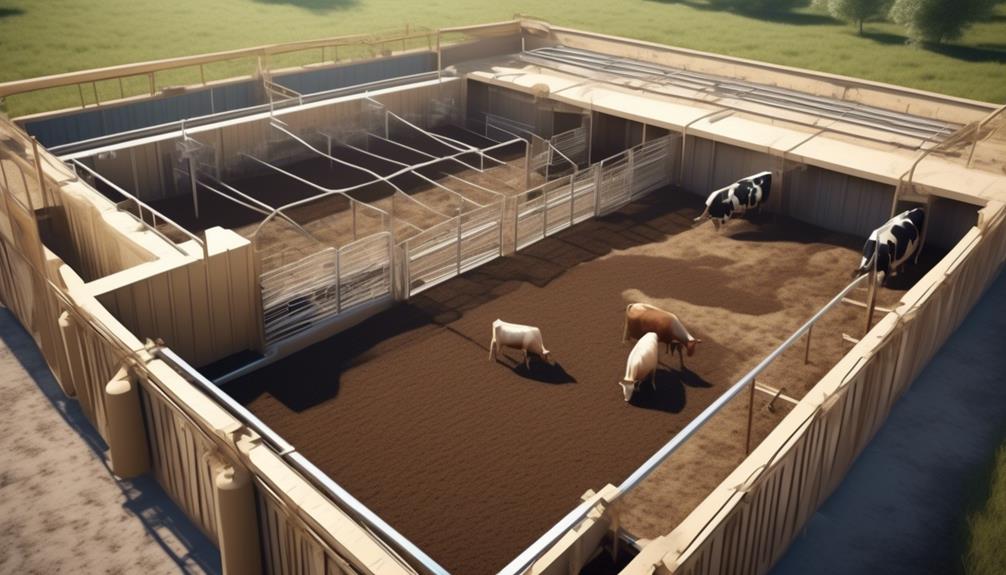
Consider implementing a robust manure management system to efficiently handle waste and maintain a clean and hygienic environment for your cattle. Proper manure disposal is essential for minimizing the environmental impact of cattle operations. Manure contains nutrients that, if not managed properly, can leach into water sources and pollute the environment. By implementing effective manure composting and nutrient management strategies, you can mitigate these risks and even turn manure into a valuable resource for your operation.
Manure disposal is a critical aspect of cattle handling facilities. Improperly managed manure can lead to nutrient runoff, contaminating water sources and causing harm to the environment. To address this, modern cattle facilities are incorporating manure composting systems. Composting not only helps in waste reduction but also allows for the recycling of nutrients. This process converts manure into a valuable fertilizer while minimizing its environmental impact.
Furthermore, effective nutrient management is crucial for sustainable cattle operations. By composting manure, you can create a nutrient-rich product that can be used to enhance soil fertility. This not only reduces the environmental impact of manure but also provides a cost-effective solution for managing soil health. Implementing nutrient management plans can help maximize the benefits of manure while minimizing its potential negative effects on the environment.
Effective Sorting and Holding Pens
To maintain a clean and hygienic environment for your cattle and continue optimizing your cattle handling facilities, it's essential to focus on the design and functionality of effective sorting and holding pens. These pens play a crucial role in the efficient management of your livestock and can contribute to the overall well-being of your animals.
When designing effective sorting and holding pens, it's important to consider the following key factors:
- Animal Behavior: Understanding the behavior of cattle is essential in designing sorting and holding pens that minimize stress and agitation. Proper pen design should take into account the natural movement patterns and social dynamics of cattle, ensuring that they can be easily sorted and held without causing unnecessary distress. Incorporating curved alleys and solid barriers can help guide cattle through the pens more smoothly, reducing anxiety and facilitating efficient handling.
- Facility Maintenance: Effective sorting and holding pens should also prioritize ease of maintenance. Proper drainage, non-slip flooring, and durable materials are essential for maintaining a clean and safe environment for both cattle and handlers. Regular cleaning and upkeep of the pens are necessary to prevent the buildup of waste and pathogens, promoting the health and well-being of the animals while also ensuring a more efficient and pleasant working environment for handlers.
Technology Integration
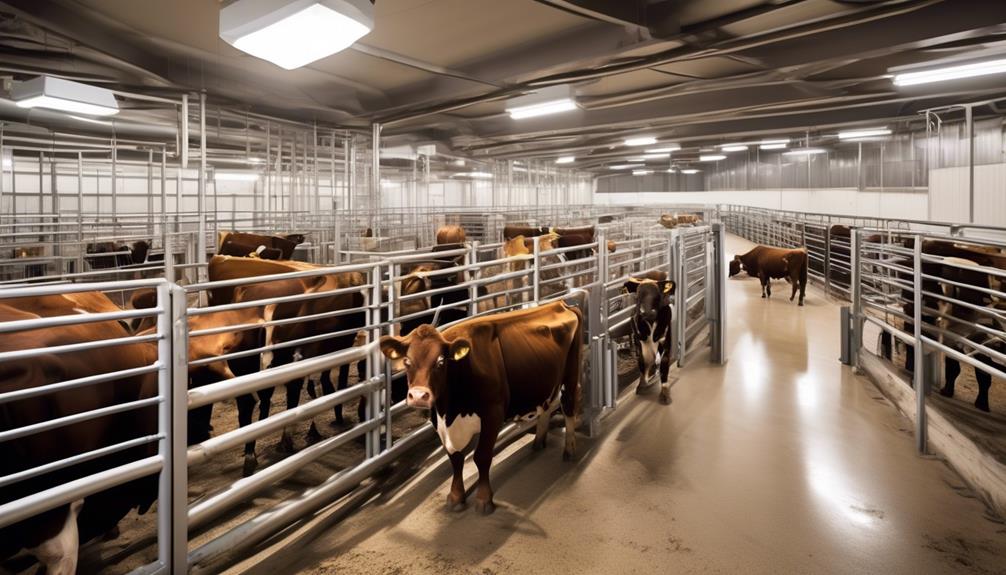
Integrating modern technology into cattle handling facilities enhances operational efficiency and promotes animal welfare. Automation integration and data tracking systems play a crucial role in streamlining cattle handling processes. By using automated sorting gates and RFID technology, you can efficiently direct cattle to specific areas without the need for manual intervention. This not only saves time but also reduces the stress on both the animals and the handlers.
Additionally, data tracking systems allow you to monitor individual animal behavior, feeding patterns, and health records, enabling you to make informed decisions for better herd management.
When it comes to promoting animal welfare, technology integration plays a significant role in stress reduction. For instance, automated weighing systems provide accurate weight measurements without causing undue stress to the animals. This minimizes the need for physical restraint and reduces the anxiety experienced by the cattle during the weighing process.
Furthermore, automated ventilation and climate control systems can help maintain optimal environmental conditions within the handling facility, ensuring the comfort and well-being of the cattle.
In essence, integrating modern technology into cattle handling facilities not only improves operational efficiency but also prioritizes the welfare of the animals. Automation integration and data tracking contribute to stress reduction and allow for better understanding of animal behavior, ultimately leading to more effective and humane cattle handling practices.
Worker Safety Considerations
Prioritizing worker safety is essential when designing modern cattle handling facilities. Ensuring that your workers are protected from potential hazards and have ergonomically designed work environments won't only improve their well-being but also enhance their productivity and efficiency.
Here are key worker safety considerations to keep in mind when designing cattle handling facilities:
- Ergonomic Design: Incorporating ergonomic principles into the layout and design of the facilities can significantly reduce the risk of musculoskeletal injuries among workers. Utilize adjustable workstations, anti-fatigue mats, and mechanical lifting aids to minimize physical strain and discomfort. Additionally, providing adequate lighting and ventilation can contribute to a healthier and more comfortable work environment.
- Hazard Prevention: Implementing measures to prevent accidents and injuries is crucial. This includes installing non-slip flooring in areas where workers are likely to encounter moisture or manure, as well as placing prominent warning signs near potential hazards such as gates, chutes, and electrical panels. Regular equipment maintenance and safety inspections should also be conducted to identify and address any potential dangers.
- Training and Communication: Proper training on safe handling procedures and equipment operation is essential for preventing accidents. Clear communication of safety protocols and emergency procedures is equally important. Regular safety meetings and open lines of communication between management and workers can help create a culture of safety and accountability within the facility.
Frequently Asked Questions
What Are the Best Practices for Integrating Technology Into Modern Cattle Handling Facilities?
When integrating technology into modern cattle handling facilities, you can improve automation and efficiency. By utilizing advanced systems for monitoring and managing livestock, you can streamline operations and enhance overall productivity.
What Are the Most Common Safety Considerations for Workers in Cattle Handling Facilities?
When working in cattle handling facilities, safety is a top priority. Ergonomic designs ensure worker safety by minimizing strain and injury. Proper training and equipment also play crucial roles in maintaining a safe and efficient work environment.
How Can Modern Cattle Handling Facilities Effectively Manage Manure?
To effectively manage manure in modern cattle handling facilities, you can implement systems for composting, nutrient recycling, and utilizing manure as fertilizer. This promotes environmental sustainability and reduces waste, benefiting both the facility and the environment.
What Are Some Advanced Handling Equipment Options That Are Commonly Used in Modern Cattle Handling Facilities?
When it comes to modern cattle handling facilities, advanced equipment and handling techniques play a crucial role. Livestock behavior and stress management are key considerations for selecting the right tools to ensure efficient and safe operations.
What Are the Key Features of Effective Sorting and Holding Pens in Modern Cattle Handling Facilities?
To ensure animal welfare and efficient handling techniques, modern cattle handling facilities feature well-designed sorting and holding pens. Livestock behavior is considered in the facility design to minimize stress and optimize the handling process.
Conclusion
In conclusion, modern cattle handling facilities prioritize:
- Efficient layout
- Safe and low-stress handling
- Advanced equipment
- Proper lighting and ventilation
- Easy manure management
- Effective sorting and holding pens
- Technology integration
- Worker safety
These key features contribute to the overall well-being of the cattle, as well as the safety and efficiency of the workers.
By incorporating these features, cattle handling facilities can operate at their best, ensuring the health and productivity of the animals and the workers.
